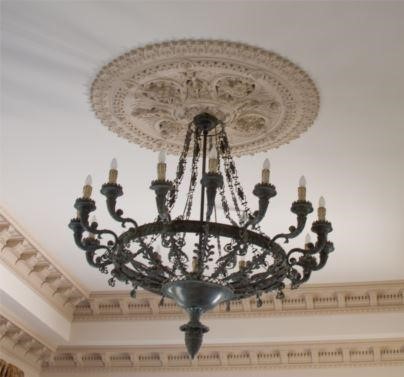If you live in a Victorian property, chances are you still have all the wonderful mouldings that were a big part of design in this period, such as coving and ceiling roses. Our Victorian ancestors loved a good dado rail, skirting board, architrave and ceiling rose. The mouldings an often be highly intricate and often made on site and bespoke for grand mansions and townhouses. Sadly, during the 1970s and 80s, many of these mouldings were removed to make way for modernisation and changing décor tastes. If you feel your rooms look a little lost without them, perhaps you are considering reinstalling such period features?
Whether you own a period home or a new build, choosing classy, stylish mouldings can complete the look of a room, leave it looking well-dressed and sophisticated.
Originally, ceiling roses were designed for hiding unattractive wiring and also to catch soot from gas lamps before it could spread onto the ceiling. Today, they still perform the decorative function, if not the gas lamp one.
When choosing a ceiling rose, if your home is a grand, old property with high ceilings then the best way to stay faithful to history is with a large and highly decorative ceiling rose. Ideal designs to look for include leaf mouldings or egg and dart designs for any moulding. Contemporary homes benefit from cleaner lines and simpler shapes. Even a Victorian-era home can look great when given a modern twist, so if you’re seeking to redecorate with lighter shades and modern touches, a simpler design ensures that the rose doesn’t impose too much on the overall décor.
A general guideline is that the higher the ceiling, the bigger you can go with your ceiling rose. Narrow, small or low ceiling rooms ideally suit smaller versions. To get a good idea, measure your room ceiling height x length x width. You can test how a rose will look by cutting out a circle of cardboard or coloured paper to the rough dimensions and use some blue tack to fix it to the ceiling above your head. Stand in the corner of the room and see how it looks, remembering that the actual rose will have some depth to it too.
When you fix a light onto the rose, the impact it has will be lessened as the light then becomes the focal point of the ceiling. Should you be opting for a grandiose and dazzling chandelier, you may wish to upscale the size of the ceiling rose, so it is not completely dwarfed in comparison.
The reverse is also true, in that if you want the ceiling rose to be the main attraction, then choose a much simpler, non-fussy light to complement the design. With plain varieties, brass varieties, leaves and flowers or concentric rings, there are so many patterns to choose from but it’s important that it blends well with the light fitting choice. Remember that any mouldings with an intricate pattern will attract dust, so the best way to keep them bright and fresh is to give them a regular wipe.
















